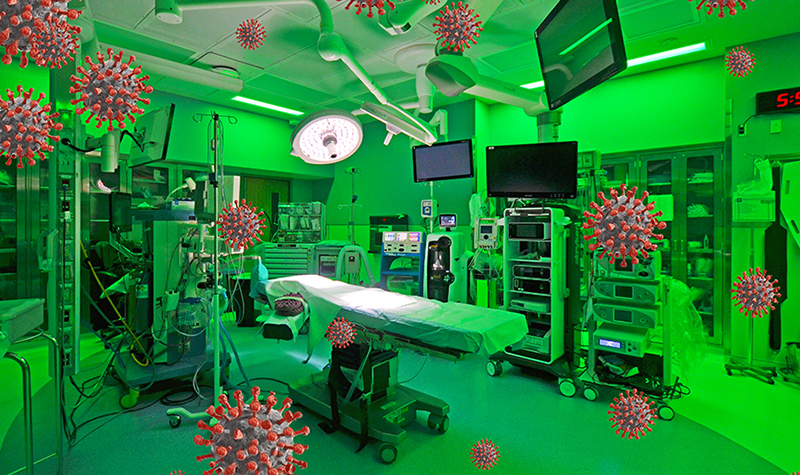
Positive pressure in the operating room (OR) should stay consistent and should not be altered into a negative pressure OR for any reason including the surgical needs of a COVID-19 positive patient or a person under investigation (PUI) of being infected with Coronavirus.
When the OR’s normal pressure relationship is modified, many challenges and potential problems become apparent.
- Demand for air balancing responses in an attempt to protect patients in operating rooms and protective environment rooms from airborne pathogens that may be present in adjacent areas.
- Demand for air balancing in an attempt to protect sterile medical and surgical supplies in supply rooms from airborne contaminants that may be present in adjacent rooms.
- FGI Guidelines persistently advises against the HVAC design of a surgical suite with altering pressures and should stay positive.
- CDC Infection Control Guidelines, 2005 persistently advises against using negative pressure within the OR on a patient with active TB disease.
- It’s important to note that SARS CoV 2, the origin of COVID – 19, does not match the aerobiology of Mycobacterium tuberculosis (M tb) which is one of the prototypical airborne infectious agents.
- Since the air exchanges in most OR’s range from 15 – 20 per hour, this will clear particulates the size of M tb in minutes and references the CDC’s table on this which was originally included in the 2005 TB Guideline.
- Respiratory secretions are where the majority of the virus is contained in patients. The virus drops out of these respiratory secretions, once produced, within 1 – 2 meters. Other smaller particulates can be formed during an aerosol generating procedure (AGP) but these particulates aren’t likely to remain afloat due to the expanse of M tb. Additionally, these other smaller particulates have little to no risk of remaining active even if apprehended by return air.
Of course, each patient infected with COVID – 19 or a PUI for COVID – 19 infection should have surgery procedures limited to only urgent needs and if the surgical procedure can be postponed until the patient is free of COVID – 19 that is even better. Healthcare systems across the world who have been dealing with this pandemic have greatly reduced elective surgeries causing surgery scheduling for COVID – 19 patients to happen when the hospital staff is readily available.
If a COVID – 19 positive patient needs general anesthesia, the best plan is to intubate the patient in an airborne infection isolation room (AIIR). The coronavirus present in the patient’s respiratory tract is more effectively contained when the patient is intubated. Intubation is an AGP and should be carried out in an AIIR, if possible. It’s important to note that during an AGP other smaller particulates can be produced but these particulates are not likely to stay afloat to the degree of M tb and have a very small risk of remaining active even in apprehended by return air. Another important item to note is that if an anesthesia professional deems it safe to provide inside the OR or if AIIR is not available, then all hospital staff members going into the specific room need to be wearing appropriate PPE, e.g. N95 respirator, eye protection, gown and gloves.
Attachment 1 – Temporary Modifications to Prepare Two-Room Surgery Suite for Airborne Infection Isolation
When working with a healthcare system, two of their hospital facilities were required to each set up an OR for COVID – 19 patients. The use of a portable HEPA unit was implemented in the OR but it was arranged to filter air going into a return air grille. This portable HEPA filter enabled a positive pressure room while ensuring that no particulates were returned from the room back to the HVAC system. A temporary anteroom was also created to capture air emerging from each of the ORs. In order to keep the anteroom negative for both ORs and the corridor, discharge from a HEPA filter unit in the anteroom was ducted to the surgical corridor.
The temporary modifications for the preparation of a two-room surgery suite with airborne infection, depicted in Attachment 1, is a precaution that we are unsure is truly necessary. For now, we are going to keep implementing this relatively simple installation that can be installed in as little as one day. This installation includes air balance measurements and control system adjustments. Not only does this precaution seem reasonable but it is simple to replicate at other facilities and can be setup for a single OR too.
Attachment 2 – Pilot Study of Directional Airflow and Containment of Airborne Particles in the Size of Mycobacterium Tuberculosis in an Operating Room
The attached airflow and containment investigation was executed in a real OR and used particulates that were comparable in size and aerobiological dynamics as M tb. Methods summarized in this investigation were successful in prohibiting transmission of M tb during surgery in the OR. As for prohibiting transmission of SARS CoV 2 in the OR, there is no reason to believe this investigation would not be as effective and has even been said to be more effective in preventing transmission of COVID – 19.